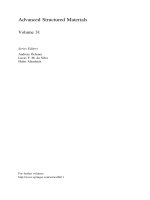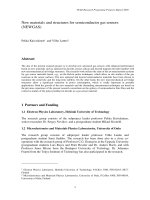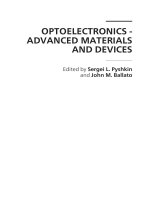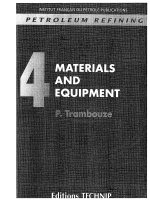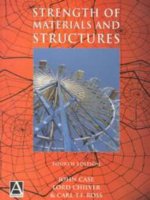MATERIALS AND NUTRIENT CYCLES
Bạn đang xem bản rút gọn của tài liệu. Xem và tải ngay bản đầy đủ của tài liệu tại đây (409.2 KB, 11 trang )
MATERIALS AND NUTRIENT CYCLES
The energy that flows into an ecosystem cannot be recycled. Once the energy is used, it is lost. But
it much be constantly repeatedly replenished if the ecosystem is to continuously function.
The important chemical nutrients, however, are used repeatedly. They are cycled between the living
and nonliving components of the ecosystem. Generally, they begin in the abiotic part of the
ecosystem (water, land, and air). Then, they enter to the bodies of plants and animals and return
into the abiotic environment.
The movement of these materials and nutrients between the living and nonliving environment
clearly shows the interrelatedness of the abiotic and biotic components in an ecosystem. Among
these recycled materials and nutrients are carbon, oxygen, water, nitrogen, and phosphorus.
After studying this chapter, you should be able to
1. Identify different nutrients that can be recycled.
2. Explain the water, carbon and oxygen, nitrogen, and phosphorus cycles.
3. Discuss the importance of each of these cycles.
4. Discuss how people affect these cycles.
5. Differentiate micronutrients from macronutrients
2.1. IMPORTANCE OF THE NUTRIENT CYCLES
The energy from the sun flows to the plant goes to the herbivore that eats the plant, to the
carnivore, and to the last consumer until the energy is lost into the ecosystem. The energy does not
go back to the source. It cannot be used over and over again.
In contrast, when the bodies of dead plants and animals decompose, they are changed into nutrients
through the action of bacteria and fungi. The nutrients are stored in the abiotic environment like the
soil. The nutrients can be used again by the plants. The plants are eaten by the animals and when
the animals die, they decompose into nutrients. These nutrients can be used over and over again. In
this way, a cycle of nutrients is formed.
The cycle of nutrients is an important process that takes place in the ecosystem. Through the cycle
of nutrients, the organic compounds found in the bodies of organisms are converted into inorganic
compounds which serve as nutrients to the other organisms. In both processes of energy flow and
nutrient cycles, the plants provide the link by which the biotic and abiotic components interact with
one another.
Insightfulness
Energy cannot be recycled. When using, it is lost into the ecosystem.
The nutrients in an ecosystem can be used over and over again. They are cycled beginning from the
nonliving environment: air, water, and soil. Then, these substances are taken in by the producers
and are passed on through several consumers. They are returned to the nonliving environment by
decomposers.
Nutrients may be classified into two types, namely, the macronutrients and the micronutrients. The
macronutrients are those that are required by the organisms in large quantities. Examples are
carbon, hydrogen, oxygen, and nitrogen. Sulfur, phosphorus, and potassium are also macronutrients
but are needed by organisms in smaller quantities. The micronutrients are needed in very small
amounts. They are also essential to life. Examples are copper, zinc, iron, and boron.
The macronutrients are the major components of fats and carbohydrates. They make-up the cell
structures of plants and animals. The cell walls of plants, for example, are made up of a very rigid
substance called the cellulose. Cellulose is made up of these three elements with a ratio of 7.2
carbons, 1 hydrogen and 8 oxygen. This substance makes the cell walls very firm and rigid. It adds
strength to the plant.
Nitrogen, carbon, hydrogen, and oxygen are the building blocks of proteins. Phosphorus makes up
many nucleic acids and is also essential for the transformation of energy in the cells.
The micronutrients are as important as the macronutrients. Magnesium, for example, is necessary
in the production of chlorophyll.
Guide questions
1. What happens to the energy from the sun when it enters to an ecosystem?
2. What happens to the dead bodies of plants and animals in an ecosystem?
3. Define macronutrients and micronutrients.
4. Make a listing of micronutrients and macronutrients, and give their functions?
5. What are the components of cellulose?
2.2 THE WATER CYCLE
As with any cycle, the water cycle has neither beginning nor end. However, it is useful to choose a
starting point. Let us begin with water vapor in the atmosphere.
a)
b)
Figure 2.1: The water cycle
When water in the atmosphere reaches saturation (the highest amount of moisture that the air can
hold), it falls as rain. This falls directly to the land and bodies of water like the oceans and seas.
Some runs off the surface of the land into rivers. The rain that falls on the land is absorbed by
plants through the roots and drank by animals. Some penetrates the soil and becomes part of the
underground water, which eventually empties into the oceans. The processes of condensation and
precipitation are responsible for the return of water from the atmosphere into the land and other
bodies of water.
The water from the land and other bodies of water returns to the atmosphere through the process of
evaporation. Plants return the water by the process known as transpiration, while animals do this
through respiration. Water accumulates again in the atmosphere as clouds and falls as rain.
Guide questions
1. What is saturation?
2. What is evaporation?
3. What is respiration?
4. Trace the pathway of the water cycle.
2.3. THE CARBON AND OXYGEN CYCLE
Much of the carbon in the environment exists in the form of carbon dioxide. Plants absorb this gas
though the leaves and use in the process of photosynthesis. Oxygen is given off during this process.
Animals and other consumers obtain their food as well as their oxygen needs from plants. In the
process of respiration, the food is broken down into CO
2
and water which are returned into the
atmosphere.
Figure 2.2: The carbon and oxygen cycles
When the animals and plants die, their bodies and waters are broken down by the decomposers. In
this process, CO
2
is produced and returned to the atmosphere. Sometimes dead organisms fail to
decompose quickly. When this happens, the dead bodies change to coal, oil, and gas which become
fossil fuels after a long time. When burned, fossil fuels release carbon dioxide into the atmosphere.
Insightfulness
Carbon dioxide is present in the atmosphere from wastes, dead bodies of organisms, and fossil
fuels.
Plants use CO
2
in the process of photosynthesis. Animals obtain their food from the plants and
release CO
2
though the process of respiration. Decomposers and burning also release CO
2
into the
environment.
Erupting volcanoes emit carbon dioxide. The eruption of the volcano supplies fresh carbon to the
atmosphere from the deeper part of the interior of the earth.
Carbon dioxide combines with water and forms calcium carbonate (CaCO
3
). This compound is
used in the production of shells of animals like clams and oysters. When shelled organisms die, the
calcium carbonate may dissolve or form part of carbonate rocks serve as an buffer environment and
storing carbon for many years. During the process of weathering, carbon dioxide is again released
into the environment.
Guide questions
1. What are the sources of carbon dioxide?
2. What are the sources of oxygen?
3. How is carbon released from carbonate rocks into the atmosphere?
4. How are fossil fuels formed?
5. What two important processes are involved in the cycle of carbon and oxygen? Discuss
these processes.
2.4. THE NITROGEN CYCLE
Nitrogen is an element crucial to life. It is an important component of proteins and nucleic acids.
The nitrogen gas constitutes about 78 percent of the air in the atmosphere. However, it cannot be
used directly by plants and animals. Plants use it in the form of nitrates.
You inhale large quantities of nitrogen but it remains in your body unchanged.




